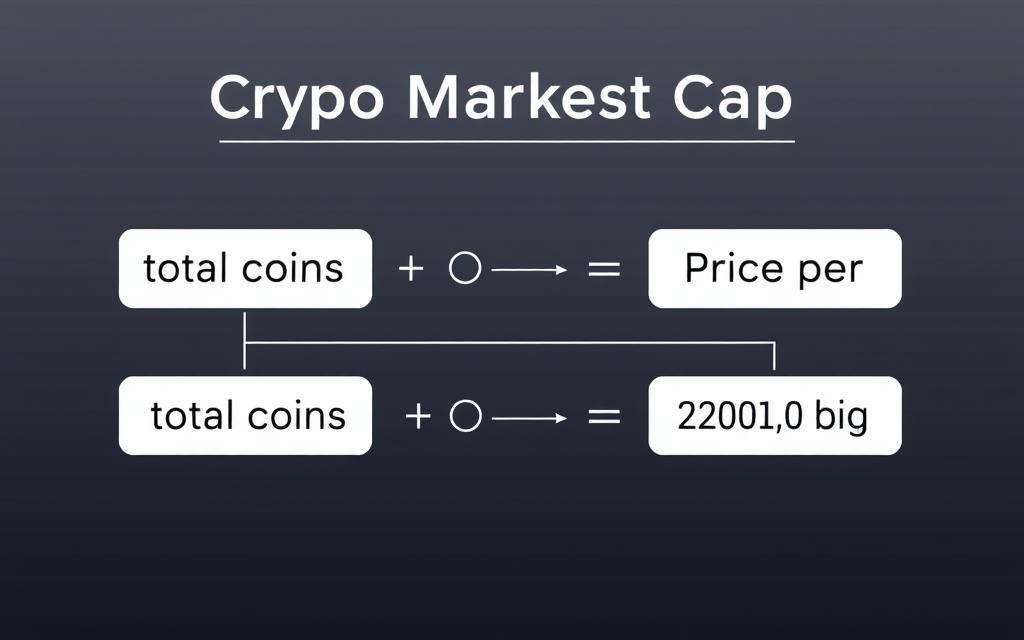Table of Contents
When evaluating digital assets, market capitalization stands as the go-to metric. It represents the total value of all coins or tokens currently in circulation. Much like stocks, this figure helps gauge a cryptocurrency’s overall standing in the financial landscape.
Calculating market cap is straightforward: multiply the current price by the circulating supply. For example, if Bitcoin trades at $40,000 with 19.5 million coins available, its valuation reaches $780 billion. Platforms like CoinMarketCap use this method to rank assets by size.
This measurement matters because it reflects investor confidence and adoption levels. Larger valuations typically indicate established networks with proven utility. Unlike traditional markets, digital asset valuations can fluctuate rapidly based on technological developments and community support.
What Is a Crypto Market Cap?
Market capitalization serves as the backbone of cryptocurrency valuation. It quantifies a project’s size by multiplying its current price by the circulating supply. For instance, a token priced at $5 with 10 million coins in circulation holds a $50 million market cap.
Defining Market Capitalization in Cryptocurrency
Unlike traditional stocks, crypto market cap focuses solely on tokens actively traded. The circulating supply excludes reserved or locked assets, offering a clearer picture of available liquidity. Projects like Bitcoin use this metric to showcase adoption, while newer tokens may highlight growth potential.
How It Differs from Traditional Market Cap
Corporate valuations rely on outstanding shares, but cryptocurrency markets prioritize free float principles. Consider Ethereum: its infinite token supply requires analysis of issuance rates, unlike Tesla’s fixed shares. Decentralized networks also lack centralized financial reports, making total value assessments more dynamic.
Volatility further separates these markets. Crypto trades 24/7, with prices swinging faster than NYSE-listed stocks. A token’s market cap can double or halve within weeks, demanding agile investment strategies.
How Is Crypto Market Cap Calculated?
Investors rely on precise formulas to measure cryptocurrency valuations. The process combines real-time price data with the circulating supply of tokens. This approach offers a transparent snapshot of a project’s financial scale.

The Formula: Price × Circulating Supply
Bitcoin’s valuation hit $1.14 trillion in February 2025. This figure came from multiplying its $57,876.81 price by 19.73 million coins in circulation. Ethereum’s cap follows the same formula, adjusting for its unlimited supply.
Understanding Circulating vs. Total Supply
Bitcoin’s total number coins will never exceed 21 million. Yet only 19.5 million are actively traded. Lost coins (estimated 3.7 million) further reduce liquid supply. Projects like XRP complicate calculations with escrowed tokens.
| Metric | Bitcoin (BTC) | Ethereum (ETH) |
|---|---|---|
| Price (Feb 2025) | $57,876.81 | $3,210.50 |
| Circulating Supply | 19.73M | 122.37M |
| Market Cap | $1.14T | $393B |
Why Circulating Supply Matters More
Exchanges prioritize circulating supply to reflect tradable assets. Fully diluted valuations mislead when tokens remain locked. Always verify a project’s liquidity before investing.
CoinMarketCap uses volume-weighted pricing across exchanges. This method prevents manipulation from low-liquidity markets.
Why Crypto Market Cap Matters
Understanding a digital asset’s true scale goes beyond its price tag. Valuation reflects collective trust, liquidity depth, and long-term viability. Projects like Bitcoin demonstrate how larger valuations correlate with reduced volatility—30% less than small-cap tokens historically.
Assessing Size and Stability
Large-cap assets (>$10B) often act as market anchors. Bitcoin’s price swings average 15% monthly, while meme coins fluctuate 150%. This stability attracts institutional investors seeking predictable returns.
Binance’s index products use market cap tiers to guide portfolios. Allocating 70% to large-caps balances risk, while smaller allocations target growth potential.
Influencing Investor Sentiment
Psychological factors play a role. Tokens in the “Top 10” list gain disproportionate attention, reinforcing dominance. During bull runs, small-caps surge 400%, but 90% crashes follow in downturns.
Metcalfe’s Law explains this: a network’s value grows exponentially with user adoption. Ethereum’s market cap tripled as DeFi users surpassed 5 million. Investors track these metrics to spot sustainable projects.
- Large-caps: Hedge against volatility with established use cases.
- Mid-caps: Offer balanced risk and innovation (e.g., Layer 2 solutions).
- Small-caps: High-reward bets, but 80% fail within two years.
Categories of Cryptocurrencies by Market Cap
Cryptocurrencies vary widely in size, each category offering distinct advantages and risks. Investors classify assets into large, mid, and small-cap tiers to balance stability with potential returns. These segments reflect liquidity, adoption, and susceptibility to volatility.

Large-Cap Cryptos: Stability and Dominance
Large-cap cryptocurrencies like Bitcoin ($2.08T) and Ethereum ($387B) dominate with valuations exceeding $10 billion. Bitcoin alone holds 60%+ market share, acting as a blue-chip asset. Their deep liquidity ($1B+ daily trades) attracts institutional investment.
Mid-Cap Cryptos: Balanced Risk and Growth
Projects like Solana ($117B) and BNB ($99B) occupy the $1B–$10B mid-cap range. Solana’s 18% annual growth outpaces Ethereum’s 9%, offering innovation without extreme risk. These assets often bridge established utility with emerging use cases.
| Asset | Valuation (Feb 2025) | Daily Trade Volume |
|---|---|---|
| Bitcoin (BTC) | $2.08T | $28B |
| Ethereum (ETH) | $387B | $9B |
| Solana (SOL) | $117B | $3B |
| BNB | $99B | $1.5B |
Small-Cap Cryptos: High Risk, High Reward
Tokens under $1B, like new DeFi or NFT projects, promise 10–100x returns but face volatility and liquidity crunches (<$10M daily trades). Many fail within two years, making them speculative investments.
Adopt strategies like Vanguard’s 60/30/10 model: 60% large-caps for stability, 30% mid-caps for growth, and 10% small-caps for upside. Beware of pump-and-dump schemes targeting low-cap coins.
Limitations of Market Cap as a Metric
While widely used, market capitalization fails to capture several underlying risks in digital assets. From inflated supply figures to exchange manipulation, this metric often paints a deceptive picture of value. Savvy investors combine it with on-chain data to avoid costly mistakes.
Market Manipulation Risks
Nearly 78% of small-cap tokens exhibit wash trading exceeding 50% of reported volume. The Squid Game token collapse revealed how fake buy walls and bot activity can inflate valuations overnight. Exchanges like FTX further distorted caps by listing synthetic assets with zero liquidity.
“Without GAAP standards, crypto reporting resembles the Wild West—investors must verify, not trust.”
- Case Study: Squid Game’s $2.1B cap vanished in minutes after founders cashed out.
- FTX’s Legacy: Faked order books artificially boosted valuations by 300%+.
- Detection Tools: Messari’s “Real Volume” filters out 90% of wash trades.
The Misleading Nature of Fully Diluted Market Cap
Projects like Ethereum advertise infinite token supplies, making their fully diluted market cap theoretical. Circulating supply metrics better reflect tradable assets, yet many investors overlook the difference. Stablecoins like USDT ($139B cap) further skew totals by double-counting collateralized dollars.
| Metric | Circulating Cap | Fully Diluted Cap |
|---|---|---|
| Ethereum (ETH) | $387B | Infinite |
| Solana (SOL) | $117B | $210B |
| New DeFi Token | $50M | $5B |
Footnotes: Fully diluted valuations assume all tokens are released—often unrealistic for locked or vested assets.
Combine market cap data with the NVT ratio (network value-to-transactions) to spot red flags. Chains with high valuations but low usage typically crash first during corrections.
How Market Cap Influences Investment Strategies
Strategic investment decisions often hinge on understanding market cap dynamics. Savvy investors use valuation tiers to balance stability and potential returns. Nearly 60% of eToro users prioritize large-cap assets for long-term portfolios, reflecting their lower volatility.

Portfolio Diversification Based on Market Cap
BlackRock’s allocation model suggests 50% Bitcoin, 30% Ethereum, and 20% altcoins. Large-caps like BTC average 35% annual growth, while small-caps surge 120%—but crash harder. Learn more about portfolio diversification strategies to mitigate risks.
- Dollar-cost averaging: Spread buys across cap tiers to smooth entry points.
- Hedge fund tactics: Use large-caps as collateral for small-cap trading.
- Tax efficiency: Long-term holds (1+ years) reduce capital gains on large-caps.
Aligning Market Cap with Risk Tolerance
Risk tolerance dictates allocations. Conservative investors favor Bitcoin’s stability, while aggressive traders target small-caps. Rebalance quarterly to maintain target ratios—overexposure to one tier amplifies losses during downturns.
“Mid-caps like Solana offer the sweet spot: innovation without extreme volatility.”
Monitor growth metrics like user adoption and transaction volume. Chains with high valuations but low activity often correct sharply. Pair market cap data with on-chain analytics for smarter investment decisions.
Common Misconceptions About Crypto Market Cap
Many investors mistakenly equate low token prices with bargain opportunities. Shiba Inu’s $0.00003 price and $16B valuation reveal why this logic fails—its 589 trillion coins inflate the number but not intrinsic value.

Price vs. Market Cap: Why the Difference Matters
Bitcoin’s $57,000 price and Shiba Inu’s fraction-of-a-cent cost don’t reflect true scale. Market cap combines price and circulating supply, exposing overvalued projects. Terra/LUNA’s $40B collapse proved high valuations can vanish overnight.
- Cheap coin fallacy: 1,000 SHIB tokens ($0.03) ≠ 0.0001 BTC ($5.70) in utility.
- Supply inflation: Dogecoin’s 5B annual minting erodes scarcity.
Market Cap Doesn’t Equal Liquidity
USDT’s $139B market cap masks its $30B daily volume—a 4.6:1 ratio. Compare this to Bitcoin’s healthier 1:1.2 ratio. Thin order books (volatility.
| Asset | Market Cap | Daily Volume |
|---|---|---|
| Bitcoin (BTC) | $1.14T | $28B |
| Shiba Inu (SHIB) | $16B | $300M |
| New DeFi Token | $50M | $1.2M |
Use CoinGecko’s bid-ask spread tool to gauge real liquidity. Projects with e.g., Ethereum) offer safer exits than low-volume tokens.
Conclusion
Smart portfolio building starts with understanding valuation metrics. Market cap—calculated as price multiplied by circulating supply—helps gauge risk and stability across assets.
Large-cap tokens offer lower volatility, while smaller projects promise growth potential but demand caution. Never rely solely on this metric; combine it with transaction volume and adoption rates.
The crypto market now sees institutions adopting cap-weighted indices. Tools like CoinMarketCap simplify research with filters for supply and liquidity.
Make informed investment decisions by tracking real-time data. Remember: valuations shift fast—stay updated to navigate shifts confidently.
FAQ
How is cryptocurrency market capitalization calculated?
It’s determined by multiplying the current price of a token by its circulating supply. This excludes locked or reserved coins, focusing only on those actively traded.
Why does circulating supply matter more than total supply?
Circulating supply reflects actual tradable volume, directly impacting price discovery and liquidity. Total supply includes future releases that may never enter circulation.
What separates large-cap from small-cap cryptocurrencies?
Large-cap assets like Bitcoin and Ethereum show lower volatility with established networks, while small-cap tokens offer higher growth potential but carry greater risks.
Can market cap indicate a cryptocurrency’s stability?
Generally, yes. Larger market cap projects typically demonstrate stronger network effects and adoption, though exceptions exist during extreme market conditions.
How does market cap influence investment decisions?
Investors use it to gauge risk exposure – large caps for stability, mid-caps for balanced growth, and small caps for speculative opportunities.
What’s wrong with relying solely on market cap metrics?
It doesn’t account for liquidity depth or trading volume. Some tokens appear large by capitalization but suffer from poor market depth.
Does a high market cap guarantee lower volatility?
Not always. While generally more stable than small caps, even major cryptocurrencies can experience significant price swings during market events.
How often should investors check market cap rankings?
Regular monitoring helps track sector trends, but daily checks aren’t necessary for long-term holders. Weekly or monthly reviews often suffice.









